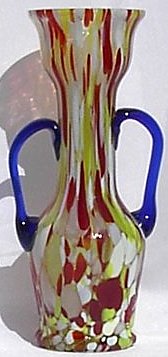
above: spatter glass
vase made c. 1930s
in Czechoslovakia

If you are looking for
Spatter Glass there
is always some for sale
on eBay. See what there
is just now - click
Spatter glass 
|
Spatter Glass: A short explanation:
Spatter Glass is hand-blown glass which has been rolled over a hot marver (usually a heated steel or iron plate) to pick up small chips of crushed glass or powdered glass on the outside of the molten gather of glass. The glass is rolled smooth and shaped by blowing (often by blowing into a mold to shape the final piece). Sometimes another layer of translucent glass is added to coat the layer of colored spatters.
The technique has been used since Roman times, and there are some superb Roman examples of spatter glass or splashed glass vases. It was also used as a form of decoration on jugs, vases, decanters and other items made of crude window glass in the eighteenth and early 19th centuries in France, Spain, and England. The famous Nailsea glass and Wrockwardine glass from the early 19th century included this type of decoration, with white and sometimes colored splashes on a dark green or amber glass. Spatter glass was resurrected in the late 19th century, along with many other Roman and Egyption techniques which became popular with the Victorians.
Several different patents were taken out in the 1880s and 1890s in the USA and in Europe for making various kinds of spatter glass. The name Spatterglass was patented to J. S. Irwin (Saltsburg, Pennsylvania) in 1893. Harry Northwood had great success with his spatter glass versions of Royal Ivy and Rubina glassware from 1890. Hobbs Brockunier made both Spangle glass (with metallic inclusions) and spatter glass in the mid 1890s.
Spatter glass has been made in Bohemia since the 1880s, and reached a peak of popularity and output volume in the 1930s. There were many new designs in the 1920s which continued to be produced through the 1930s until the war with Germany caused massive disruption to the Czechoslovakian glass industry.
Alternative names:
There were many different names used for spatter glass in the late 19th century and more recently. Splashed glass, end-of-day glass, mottled overlay glass, and spatterglass are all generic names which have been applied to the same kind of glass, similar to the vase shown in the picture above left. Note that if the term "end-of-day glass" means glass made at the end of the day to use up the glass left in the pots, then it should not be applied to spatter glass. As Charles Hajdamach pointed out, there were so many patents taken out for this kind of glass that it must have been a normal part of the glassworks production.
There are some very similar kinds of glass that are known by different names, such as Peloton glass, spangled glass, tortoiseshell glass and vasa murrhina. They refer to the following kinds of glass.
Peloton glass (Kralik of Harrach, Bohemia 1880) is blown glass with thin strands of colored glass embedded and then coated in clear glass.
Spangled glass (Hobbs Brockunier, USA 1884) includes metallic flakes (often mica).
Tortoiseshell glass (Pohl & Wittman, England 1880) is blown amber glass with brown spatters, looking like tortoiseshell.
Vasa murrhina (Boulton, England 1879; Farrell USA 1882; and others) is blown glass with mica, metal-coated particles, or aventurine as well as colored spatters and often a colored overlay.
|
